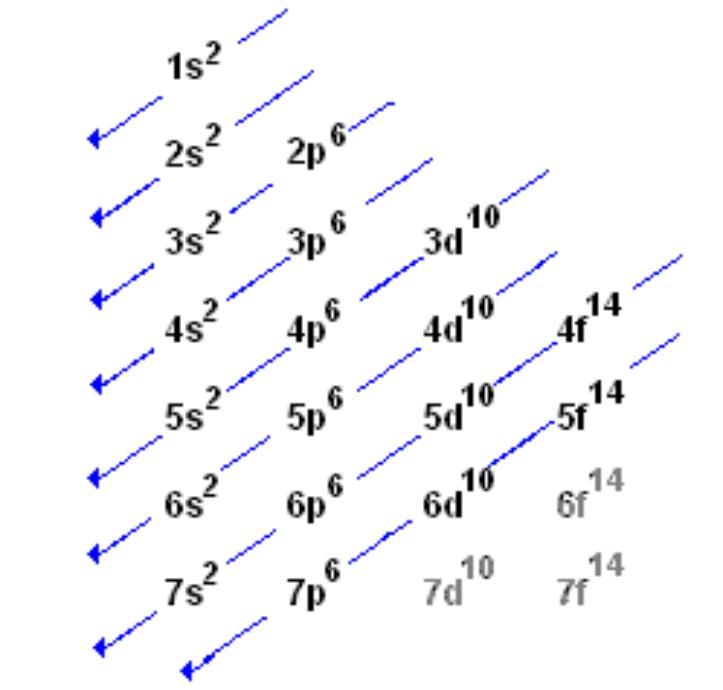Math Is Fun Forum
You are not logged in.
- Topics: Active | Unanswered
Pages: 1
#1 2024-06-05 00:19:33
- Jai Ganesh
- Administrator

- Registered: 2005-06-28
- Posts: 52,350
Electronic Configuration
Electronic Configuration
Gist
The electron configuration of an atomic species (neutral or ionic) allows us to understand the shape and energy of its electrons. Many general rules are taken into consideration when assigning the "location" of the electron to its prospective energy state, however these assignments are arbitrary and it is always uncertain as to which electron is being described. Knowing the electron configuration of a species gives us a better understanding of its bonding ability, magnetism and other chemical properties.
Summary
Electronic configuration, the arrangement of electrons in orbitals around an atomic nucleus. The electronic configuration of an atom in the quantum-mechanical model is stated by listing the occupied orbitals, in order of filling, with the number of electrons in each orbital indicated by superscript. In this notation, the electronic configuration of sodium would be 1s22s22p63s1, distributed in the orbitals as 2-8-1. Often, a shorthand method is used that lists only those electrons in excess of the noble gas configuration immediately preceding the atom in the periodic table. For example, sodium has one 3s electron in excess of the noble gas neon (chemical symbol Ne, atomic number 10), and so its shorthand notation is [Ne]3s1.
Electrons fill orbitals according to the Aufbau principle, in which the lowest energy orbitals are filled first. Orbitals are filled as 1s22s22p63s23p64s23d104p65s24d105p66s24f145d106p67s25f146d107p6.
Elements in the same group in the periodic table have similar electronic configurations. For example, the elements lithium, sodium, potassium, rubidium, cesium, and francium (the alkali metals of Group I) all have electronic configurations showing one electron in the outermost (most loosely bound) s orbital. This so-called valence electron is responsible for the similar chemical properties shared by the abovementioned alkali elements in Group I: bright metallic lustre, high reactivity, and good thermal conductivity.
According to the older shell atomic model, electrons occupy several levels from the first shell nearest the nucleus, K, through the seventh shell, Q, farthest from the nucleus. The electronic configuration of an atom in the shell atomic model may be expressed by indicating the number of electrons in each shell beginning with the first. For example, sodium (atomic number 11) has its 11 electrons distributed in the first three shells as follows: the K and L shells are completely filled, with 2 and 8 electrons respectively, while the M shell is only partially filled with one electron.
Details
In atomic physics and quantum chemistry, the electron configuration is the distribution of electrons of an atom or molecule (or other physical structure) in atomic or molecular orbitals. For example, the electron configuration of the neon atom is 1s2 2s2 2p6, meaning that the 1s, 2s, and 2p subshells are occupied by two, two, and six electrons, respectively.
Electronic configurations describe each electron as moving independently in an orbital, in an average field created by the nuclei and all the other electrons. Mathematically, configurations are described by Slater determinants or configuration state functions.
According to the laws of quantum mechanics, a level of energy is associated with each electron configuration. In certain conditions, electrons are able to move from one configuration to another by the emission or absorption of a quantum of energy, in the form of a photon.
Knowledge of the electron configuration of different atoms is useful in understanding the structure of the periodic table of elements, for describing the chemical bonds that hold atoms together, and in understanding the chemical formulas of compounds and the geometries of molecules. In bulk materials, this same idea helps explain the peculiar properties of lasers and semiconductors.
Electron configuration was first conceived under the Bohr model of the atom, and it is still common to speak of shells and subshells despite the advances in understanding of the quantum-mechanical nature of electrons.
An electron shell is the set of allowed states that share the same principal quantum number, n, that electrons may occupy. In each term of an electron configuration, n is the positive integer that precedes each orbital letter (helium's electron configuration is 1s2, therefore n = 1, and the orbital contains two electrons). An atom's nth electron shell can accommodate 2n2 electrons. For example, the first shell can accommodate two electrons, the second shell eight electrons, the third shell eighteen, and so on. The factor of two arises because the number of allowed states doubles with each successive shell due to electron spin—each atomic orbital admits up to two otherwise identical electrons with opposite spin, one with a spin +1⁄2 (usually denoted by an up-arrow) and one with a spin of −1⁄2 (with a down-arrow).
A subshell is the set of states defined by a common azimuthal quantum number, l, within a shell. The value of l is in the range from 0 to n − 1. The values l = 0, 1, 2, 3 correspond to the s, p, d, and f labels, respectively. For example, the 3d subshell has n = 3 and l = 2. The maximum number of electrons that can be placed in a subshell is given by 2(2l + 1). This gives two electrons in an s subshell, six electrons in a p subshell, ten electrons in a d subshell and fourteen electrons in an f subshell.
The numbers of electrons that can occupy each shell and each subshell arise from the equations of quantum mechanics, in particular the Pauli exclusion principle, which states that no two electrons in the same atom can have the same values of the four quantum numbers.

It appears to me that if one wants to make progress in mathematics, one should study the masters and not the pupils. - Niels Henrik Abel.
Nothing is better than reading and gaining more and more knowledge - Stephen William Hawking.
Offline
Pages: 1